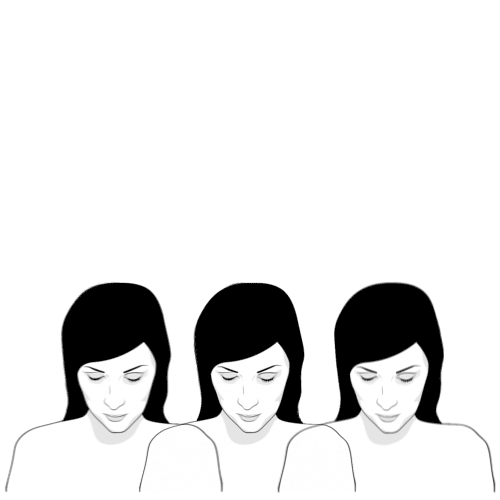The Impact of the Three Degrees of Influence Theory

In recent years, there have been many important studies focused on how people are influenced. The three degrees of influence theory came from one of them. This is a very interesting theory which encourages us to pay attention to the effects what we say and do have on others.
Some time ago, the six degrees of separation theory arose. It stated that each person was separated from the great figures of humanity by only six degrees. In other words, each one of us knows someone, who knows someone else, who knows someone else who knows Donald Trump.
The three degrees of influence theory is quite similar. However, its effects are more striking in our lives. This theory was developed by Nicholas Christakis and James Fowler in 2010. It shows that, no matter how separated we are from others, we’re never an island.
The three degrees of influence theory
According to Christakis and Fowler, what we say and do influences our friends’ thoughts and behaviors (first degree), our friends’ friends (second degree) thoughts and behaviors, and the thoughts and behaviors of our friends’ friends’ friends (third degree).

Now, how did they reach that conclusion? In the year 2007, these researchers participated in a study related to cardiovascular diseases which had started in 1948. This study was being done in the city of Framingham, in the United States. Two-thirds of the adult inhabitants participated in it and then their children and grandchildren as well.
Each participant had to make a list of relatives, friends, neighbors, and coworkers. Many of those people were also participating in the study since the city was very small. This data allowed them to make a network of relationships between the participants.
Research findings
After completing the study, 50,000 links were defined among the participants. The researchers began to cross data related to the participants’ style and quality of life. They wanted to know if the changes one of the members of this social network experienced had some kind of influence on the other members.
One of the things included in the study was obesity. Christakis and Fowler were determined to find out if, for example, the fact that someone became obese had an influence on their social network, making the others become obese as well. The results were shocking.

They were able to determine that, if someone became obese, their friends had a 45% chance of becoming obese too. In turn, their friends’ friends would have a 20% risk. And, consequently, their friends’ friends’ friends would have a 10% risk. No influence was observed beyond the third degree. This is how they established the three degrees of influence theory.
Mental and physical aspects
As a conclusion, the researchers stated that other behaviors such as smoking would also have the same effect as obesity. The three degrees of influence rule also applied in that case. Likewise, the opposite effect could also take place in both cases (obesity and smoking). If someone from the social network lost weight or stopped smoking, this affected other people’s behavior.
Both Christakis and Fowler, as well as other researchers, were able to prove that this also applies to attitudes and emotions. For example, those who are friends with lonely people tend to feel lonely as well. Something similar to this also happens with happiness, cooperative behaviors, the consumption of alcohol, and almost every single behavior and attitude.
To the researchers’ surprise, they also found that celebrities, for example, have little to no influence on people’s behaviors. If a celebrity decided to go on a diet, that wouldn’t have any effect on their followers. On the other hand, if your friend were to do that, it would influence you.

This theory makes us assume we’re not islands and that everything we do and say will have an effect on those around us, one way or another. It also tells us that, if we want to change, we must start with ourselves. In an imperceptible way, this will spread and will lead to those great changes so many people long for.
In recent years, there have been many important studies focused on how people are influenced. The three degrees of influence theory came from one of them. This is a very interesting theory which encourages us to pay attention to the effects what we say and do have on others.
Some time ago, the six degrees of separation theory arose. It stated that each person was separated from the great figures of humanity by only six degrees. In other words, each one of us knows someone, who knows someone else, who knows someone else who knows Donald Trump.
The three degrees of influence theory is quite similar. However, its effects are more striking in our lives. This theory was developed by Nicholas Christakis and James Fowler in 2010. It shows that, no matter how separated we are from others, we’re never an island.
The three degrees of influence theory
According to Christakis and Fowler, what we say and do influences our friends’ thoughts and behaviors (first degree), our friends’ friends (second degree) thoughts and behaviors, and the thoughts and behaviors of our friends’ friends’ friends (third degree).

Now, how did they reach that conclusion? In the year 2007, these researchers participated in a study related to cardiovascular diseases which had started in 1948. This study was being done in the city of Framingham, in the United States. Two-thirds of the adult inhabitants participated in it and then their children and grandchildren as well.
Each participant had to make a list of relatives, friends, neighbors, and coworkers. Many of those people were also participating in the study since the city was very small. This data allowed them to make a network of relationships between the participants.
Research findings
After completing the study, 50,000 links were defined among the participants. The researchers began to cross data related to the participants’ style and quality of life. They wanted to know if the changes one of the members of this social network experienced had some kind of influence on the other members.
One of the things included in the study was obesity. Christakis and Fowler were determined to find out if, for example, the fact that someone became obese had an influence on their social network, making the others become obese as well. The results were shocking.

They were able to determine that, if someone became obese, their friends had a 45% chance of becoming obese too. In turn, their friends’ friends would have a 20% risk. And, consequently, their friends’ friends’ friends would have a 10% risk. No influence was observed beyond the third degree. This is how they established the three degrees of influence theory.
Mental and physical aspects
As a conclusion, the researchers stated that other behaviors such as smoking would also have the same effect as obesity. The three degrees of influence rule also applied in that case. Likewise, the opposite effect could also take place in both cases (obesity and smoking). If someone from the social network lost weight or stopped smoking, this affected other people’s behavior.
Both Christakis and Fowler, as well as other researchers, were able to prove that this also applies to attitudes and emotions. For example, those who are friends with lonely people tend to feel lonely as well. Something similar to this also happens with happiness, cooperative behaviors, the consumption of alcohol, and almost every single behavior and attitude.
To the researchers’ surprise, they also found that celebrities, for example, have little to no influence on people’s behaviors. If a celebrity decided to go on a diet, that wouldn’t have any effect on their followers. On the other hand, if your friend were to do that, it would influence you.

This theory makes us assume we’re not islands and that everything we do and say will have an effect on those around us, one way or another. It also tells us that, if we want to change, we must start with ourselves. In an imperceptible way, this will spread and will lead to those great changes so many people long for.
This text is provided for informational purposes only and does not replace consultation with a professional. If in doubt, consult your specialist.







